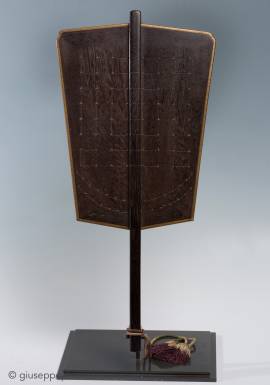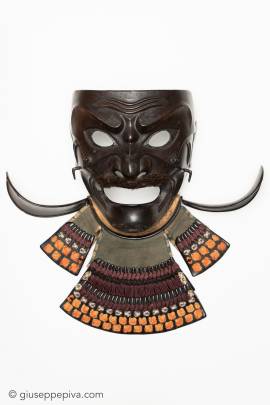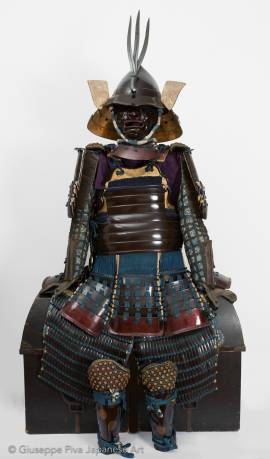Edo period, 19th century Wood with maki-e lacquer decorationsLength: 53,5 cmThe various implements used by samurai commanders to signal orders on the battered field or to direct troop movements were referred to as jineigu. Among them, the gunbai uchiwa, a fixed fan, was the equipment that was used by generals and daimyō and hence became a symbol of power.This gunbai is rather unusual among the common shapes. The straight lines and the absence of wide maki-e areas give in fact a sort of severe aspect, while the grain wood and the finely lacquered borders indicate the refined taste...
WORKS FOR SALE
A full-face russet iron samurai amour’s mask with fierce expressionEarly Edo period, 17th -18th centuryProvenance:Kyoto, Arashiyama MuseumLiterature:Kyoto Arashiyama Bijutsukan, catalog, pag. 28Iida Kazuo, Katchû-men (Tokyo, 1991), cat. 123Rare lacquered iron sōmen lacquered in kuro-urushi. The mask, with an expression both strong and elegant, is constructed in two parts only, with the nose incorporated into the upper section. This type of fabrication is found in some sōmen signed by Wushu Masanobu, of which other features, such as the shape of the side wrinkles and the protuberance...
Nerikawa Tosei gusokuLeather samurai armor PERIODLate Edo period (1615-1868), 19th century This authentic samurai armor is entirely made of lacquered nerikawa(leather) except for the iron kote. Nerikawa has always been used when building samurai armor in order to diminish its weight, but it is only during the second half of the Edo period that we find full suits made only with this material. Even the helmet, a very nice momonari kabuto decorated with a slander maedate shaped as three bamboo leaves, is made with leather.Both sode are decorated with a large figure of a...
About japanese armor
Copyright © 2016 - giuseppe piva - VAT: 05104180962










